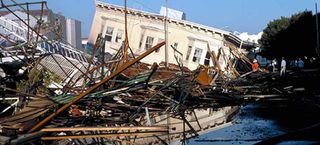The Next Big California Earthquake May Be Spread Out Over Years

(Inside Science) -- Everyone in California knows what the “Big One” means: a cataclysmic earthquake that scientists say is inevitable. It is not if the Big One will happen but when.
But a group of scientists in Northern California, looking at the geologic evidence from the last 400 years came to an alternative prediction: the Bay Area is somewhat more likely to get a series of serious quakes rather than one huge one. If that sounds like good news, it isn’t.
The San Francisco trembler of 1906 was a giant earthquake, said David Schwartz, a geologist at the U.S. Geological Survey in Menlo Park, California.
“If that would happen today, with all the additional urbanization that has occurred throughout the Bay Area and Northern California, the effect would be far worse than it would be in 1906,” he said. “On the other hand, a series of earthquakes, 6.7, 6.9, 7.1, 7.4 [on the magnitude scale] within a short period of time…when you are recovering from one earthquake and are faced with another, it is very, very different and potentially more hazardous."
“So I don’t think this is good news at all.”
The 1906 earthquake, which struck at 5:12 a.m. on April 18, is thought to have had a magnitude of 7.9. Three thousand people died in the quake and fire that followed. San Francisco was virtually destroyed. But, the city was small then, and most of the Bay Area was farms and orchards.
The most recent major earthquake in the area, the Loma Prieta in 1989, registered a magnitude of 6.9. The difference is actually huge. Each time the scale goes up a full magnitude – from 6.9 to 7.9, for example – it represents a 32-fold increase in energy release, so Loma Prieta, despite causing $6 billion in damage and killing 63 people was minor league in comparison.
Sign up for the Live Science daily newsletter now
Get the world’s most fascinating discoveries delivered straight to your inbox.
Schwartz is lead author of a paper to be published in the Bulletin of the Seismological Society of America.
One good effect of 1906 was that it released a great deal of seismic pressure, and the subsequent century has been relatively calm. Loma Prieta occurred in a fault no one knew existed, outside the major fault system.
Geologists speak of earthquake in terms of cycles. Pressure in tectonic plates builds until the strain snaps and there is a major earthquake. Things calm down while the pressure rebuilds, continuing the cycle.
Coastal California is where two huge plates hugging the surface of the planet -- the North American and the Pacific -- collide. All the faults in the Bay Area, including the San Andreas, are slipping at high rates and accommodating the movement.
“The stress on the crust is pretty much steady-state,” Schwartz said, “about 40 millimeter [1.5 inches] a year. That stress gets released by slip-on faults primarily in moderate and large earthquakes.” There is considerable variability in the intensity of those quakes.
The written record of earthquakes in the area only goes back as far as 1776, when monks at the Mission Dolores and soldiers at the Presidio began keeping records. There is no evidence of a full cycle in the records.
But, the researchers from USGS, the California Geological Survey, two consulting firms and the University of Missouri-Kansas City, went back further. They dug trenches across faults, documenting surface ruptures, using radiocarbon dating and collecting pollen. Their record goes back to 1600.
They found several large quakes between 1690 and 1776 on five of the faults, including the San Andreas, Hayward, Calaveras, Rodgers Creek and San Gregorio. The researchers think the stress released in those quakes was about equal to what happened in San Francisco in 1906.
That, to them, is a full cycle.
They concluded that there are two historic ways stress on Bay Area faults can be released: in one giant upheaval as in 1906, or through a century of lesser quakes, as happened in the 18th century.
Because the stress is spread out, they think it is somewhat likelier to have a series of quakes than the Big One. They concluded that there is a 63 percent chance of a 6.7 earthquake or higher in the next 30 years.
“This study represents a heroic amount of work,” said Greg Beroza, a professor of earth sciences at Stanford University in California.
“The basic problem in forecasting earthquakes is that we have a very limited record,” he said, “and an incomplete understanding of how earthquakes work.” What Schwartz and his colleagues did, paleoseismology, requires huge physical effort, and only works for large, surface-rupturing earthquakes, so they are recording only the "conservative lower bound.”
“The data is limited -- dates are uncertain as are magnitudes -- but despite these limitations, they have shown that the Bay Area was very seismically active during this period,” he said.
Choosing between predictions of the Big One and many smaller ones is open to interpretation.
“Pick your poison,” said Beroza.
Inside Science News Service is supported by the American Institute of Physics. Joel Shurkin is a freelance writer based in Baltimore. He is the author of nine books on science and the history of science, and has taught science journalism at Stanford University, UC Santa Cruz and the University of Alaska Fairbanks. He tweets at @shurkin.
Most Popular


